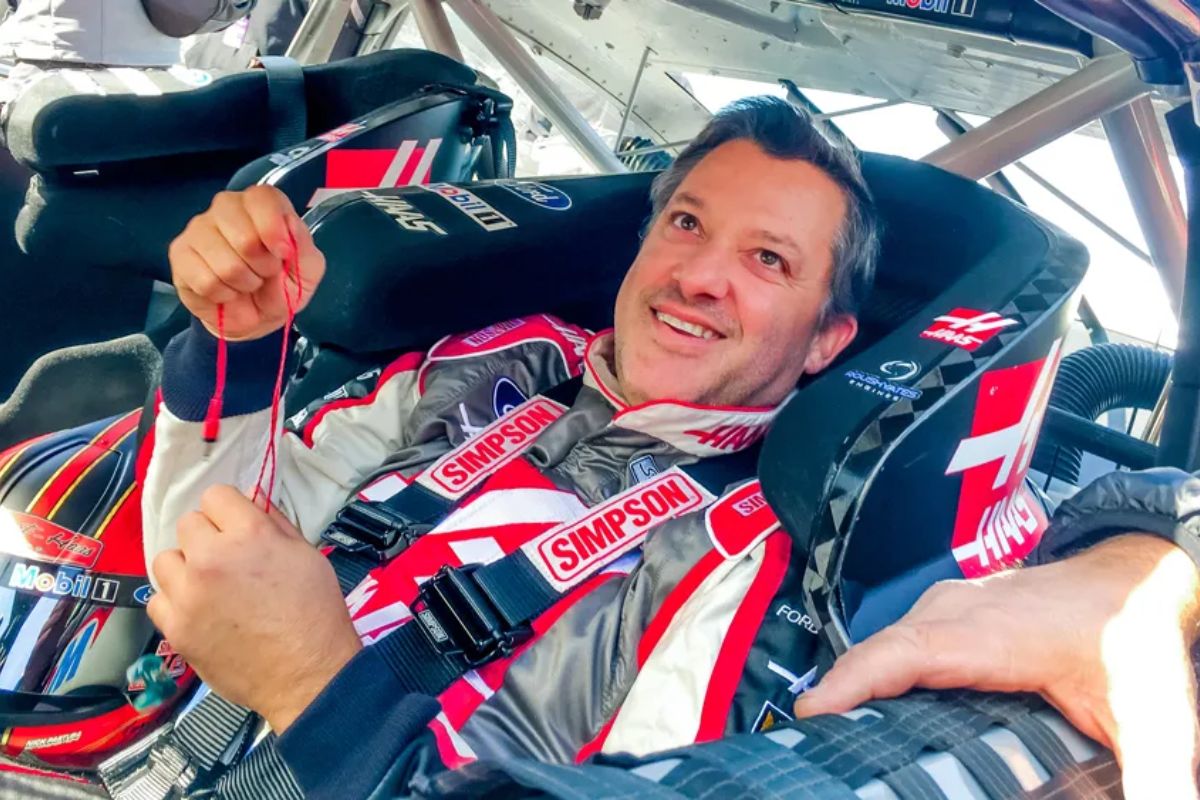Joey Gase’s Bumper Stunt Surpasses Tony Stewart’s: In a dramatic twist at the Xfinity Series race at Richmond Raceway, Joey Gase escalated motorsports’ emotional annals by forcibly removing and tossing his car’s bumper, a maneuver that starkly overshadowed Tony Stewart’s notable helmet toss in 2012. This unexpected act, born from a confrontation and mechanical frustrations, not only showed the intense competitive spirit inherent in racing but also spotlighted the intricate balance between aggression and safety protocols. Gase’s extreme response to a high-stress situation catalyzes discussions on professional conduct within the high-stakes environment of racing. Reflecting on this moment offers a profound understanding of the pressures and passions driving NASCAR’s athletes, inviting a closer look at the sport’s dynamic legacy.
Key Takeaways
- In the Xfinity Series race at Richmond Raceway, Joey Gase impulsively tore off his car’s rear bumper and threw it on another driver’s windshield.
- The incident occurred after a confrontation with driver Bayley Cram, following mechanical issues and a significant wreck during the ToyotaCare 250 race.
- Gase’s unprecedented action of throwing his bumper surpassed Tony Stewart’s memorable helmet toss at Bristol Motor Speedway in 2012 in terms of shock value.
- The act has sparked discussion on professional conduct in racing and may lead to a reevaluation of guidelines and penalties for such behavior.
- This incident highlights the intense emotions and pressure in motorsports, as well as the unpredictability and risks associated with racing.
Bizarre Moment Unfolds
In a spectacle that captivated audiences, the Xfinity Series race at Richmond Raceway took an unexpected turn when Joey Gase’s No. 35 Camaro car lost its rear bumper, setting the stage for an unpredictable chain of events. This moment, seemingly trivial in the grand scheme of a race, rapidly escalated into a spectacle that overshadowed the race itself. The detachment of Gase’s rear bumper is not merely an incident of mechanical failure but a pivotal moment that challenges the norms of racing etiquette and safety protocols.
The loss of a car component during a high-speed race introduces immediate hazards, not only to the driver from whom the part became detached but also to the entire field of competitors. High-speed debris can become a lethal projectile, posing significant risk to drivers, potentially compromising their safety. Additionally, such occurrences necessitate quick decision-making from race officials regarding caution flags and potential race stoppages to guarantee the safety of participants and spectators.
Analyzing the implications of this event, one must consider the broader context within which it unfolds. Incidents like these test the resilience and adaptability of teams, the efficiency of raceway emergency protocols, and the robustness of the cars themselves. They serve as real-time case studies for manufacturers and engineers to reassess and enhance the durability and safety features of racing vehicles.
The unpredictability introduced by Gase’s car losing its rear bumper underscores the inherent risks and challenges of motorsport, reminding all stakeholders of the critical importance of safety, preparedness, and the ever-present possibility of the unexpected.

Gase’s Reaction
Reacting impulsively to a heated altercation with Cram’s Chevy, Joey Gase’s decision to tear off his car’s rear bumper and hurl it onto his windshield as he entered pit road marks a moment of unprecedented drama in the racing world. This act, while shocking, brings to light the intense pressure and emotions that drivers often face. Joey Gase’s actions, though drastic, underline a moment of raw, unfiltered emotional response, something not commonly seen to this extent in motorsports.
The incident, while being a spectacle, raises several questions about the professional decorum expected of race car drivers and the extent to which emotions should play a part in their actions on the track. Gase’s impulsive reaction is a validation to the high-stakes environment of racing, where tensions run high, and actions can sometimes leap ahead of rational thought.
Race Context
Understanding the intense emotions highlighted in Gase’s reaction requires a closer examination of the unfolding events during the ToyotaCare 250, where mechanical issues and a significant wreck set the stage for the confrontation. The race, initially running smoothly, was ruined by mechanical troubles that plagued several drivers, demonstrating the unpredictable nature of motorsports where the fine line between success and failure often depends on the reliability of machinery. This backdrop of mechanical failures heightened the tension among drivers, as each sought to capitalize on any advantage presented by the misfortunes of others.
The critical stage came on Lap 173 when the race’s fragile balance was shattered by a major wreck, a direct result of Cram’s aggressive maneuver on Gase. As they came out of Turn 1, Dawson Cram made a bold move, getting on the inside of Gase’s car, but unfortunately, it ended in disaster. Cram’s maneuver caused Gase to spin out hard, sending him crashing into the unforgiving wall. The damage was severe, rendering the No. 35 car beyond repair. It was a tough break for the owner-driver, who had to climb out of his wrecked car.
But the drama didn’t end there. With patience wearing thin, Gase waited for Cram to return to the pit under caution. And when the moment arrived, Gase took matters into his own hands, quite literally. He tore off the rear bumper of his car and unleashed his frustration, slamming it into Cram’s windshield.
“I think him just not having his head screwed on right. I gave the kid his first opportunity ever in Xfinity and I know Johnny Davis isn’t in the business of wrecking race cars, and we’re definitely small teams, racing hard for the lucky dog, and apparently, he certainly doesn’t know how to lift. So maybe his throttle stuck, I don’t know,” Gase
Frustration can manifest in a lot of different ways 👀. pic.twitter.com/Wt4dHVS6tn
— NASCAR Xfinity (@NASCAR_Xfinity) March 30, 2024
Historical Parallel
In 2012, Tony Stewart, known for his fiery demeanor, found himself involved in a heated exchange with Matt Kenseth. As they battled on lap 333, their cars made contact, leading to a dramatic wreck that sent both drivers crashing into the unforgiving wall. Stewart’s No. 14 machine suffered irreparable damage, abruptly ending his race. However, Kenseth, displaying true grit, persevered, determined to salvage whatever points he could.
But it was after the wreck that things took a dramatic turn. Stewart, living up to his reputation as “Smoke,” decided to take matters into his own hands. As Kenseth circled back around the track, Stewart, fueled by adrenaline and frustration, waited for his moment. And when Kenseth’s car came into view, Stewart unleashed his fury, aiming his helmet at the No. 17 Ford. Remarkably, Stewart escaped a fine for his actions, but NASCAR didn’t let him off. They confiscated his helmet, turning it into a piece of memorabilia that would be talked about for years to come.
In analyzing Gase’s actions through this historical lens, one must consider how NASCAR has evolved in its handling of such expressions of frustration. The sport’s management has grown increasingly sophisticated in balancing the need for discipline with an understanding of the emotional pressures at play. This dynamic interplay between regulation and understanding shapes the context within which Gase’s actions are evaluated.

News in Brief
In the analysis of the incident involving Joey Gase’s unconventional bumper stunt, it becomes evident that this moment in motorsports history transcends mere spectacle, embedding itself within the racing lore alongside Tony Stewart’s previously unparalleled antics.
This event not only captivates the audience’s imagination but also provokes a reevaluation of the boundaries of sportsmanship and performance artistry in competitive racing.
The occurrence serves as a confirmation to the unpredictable and evolving nature of motorsports, where innovation and boldness combine, shaping its future trajectory.
Our Reader’s Queries
Q: Did Tony Stewart win Daytona 500?
A: Stewart’s quest for a Daytona 500 victory ends without a final attempt in his 17th race, a trophy that has eluded him throughout his career. However, the possibility remains for future attempts in a part-time role.
Q: Who does Joey Gase drive for?
A: Joey Gase, owner and driver of Joey Gase Motorsports in the NASCAR Xfinity Series, debuted in 2011 and has competed in 356 races across the national series. He secured one top-five finish in the Xfinity Series at Talladega in 2015.
Q: Does Tony Stewart still own a race team?
A: Stewart-Haas Racing, co-owned by Tony Stewart and Gene Haas, competes in the NASCAR Cup Series and Xfinity Series. Established in 2009, it’s one of NASCAR’s top teams, boasting three Cup Series championships.
Also Read: Tony Stewart Reveals NHRA Failure Reasons After a Wild Series of Events for Smoke!


